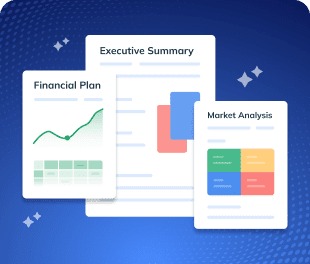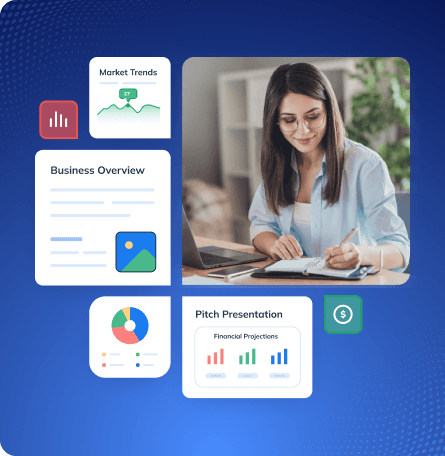Starting a business can be an exciting yet daunting endeavour. That is if you don’t have a clear plan to guide you.
Without one, it’s easy to lose focus, make costly mistakes, or struggle to turn your idea into reality.
If you’ve been part of the Prince’s Trust (now King’s Trust) Enterprise Programme, you know how having a business plan is part of their key requirement.
The programme provides a business plan template to help you validate your idea, structure your thoughts, and prepare for the launch.
But filling out that template? That’s where you might need some guidance.
In this blog post, we’ll break down the Prince’s Trust Business Plan template step by step, to help you prepare a well-structured business plan that aligns with the programme’s expectations.
What is Prince’s Trust (now King’s Trust)?
The Prince’s (now King’s) Trust is a UK-based charity established by King Charles III in 1976. This organization helps young people unlock their potential through education, training, employment, and entrepreneurship.
Amongst its many programs is the Enterprise program, designed for 18-30-year-old individuals who want to start their own businesses and become self-employed.
This program provides mentorship, business training, networking opportunities, and access to funding to help young people turn their entrepreneurial dreams into sustainable businesses.
Prince’s Trust (now King’s Trust) Business Plan Outline
The three key stages of the King’s Trust Enterprise program include:
- Business planning: Developing a clear and structured business idea
- Business launch: Turning the plan into action and starting operations
- Business advance: Scaling, sustaining, and refining the business for long-term success
While the Enterprise Programme doesn’t guarantee funding, it strongly encourages participants to create a business plan and provides the necessary support to do so. However, for many young people, building a business plan can feel intimidating.
To simplify, we have broken down the process of using their template into actionable steps with a clear outline. Following this, you will get a structured framework to think thoroughly and build your comprehensive business plan.
1. Who’s plan is this?
This section is like a name tag or the cover page of your notebook—it tells people who you are.
It’s nothing strategic or complicated. Just a couple of details to establish the basics. Think in terms of name, location, and contact details in case the reader wants to get in touch.
Here’s a quick table with the list of information this section should include.
| Category | Details |
|---|---|
| Owner details | Name of the owner |
| Business details | Name of the business |
| Contact details | Contact number, Email, and address (in case of physical location business) |
2. Executive summary
An executive summary summarizes your entire business plan in a page or two. It’s the first section of your business plan and possibly the only section, the reader (read: lender) would be reading. So make sure this section covers the high-value points of your plan.
Now, you can either weave paragraphs of information and make them flow cohesively. Or you can simply summarize each section individually, place them together, and call it a summary.
The point is to make your summary stand sufficiently such that a reader can grasp the full concept of your business idea without even reading a plan.
Here’s a quick table outlining the details your executive summary should include:
| Section | Details |
|---|---|
| Business summary | Briefly outline what you would sell, to whom, and where. Also, mention business structure, i.e. sole proprietorship, partnership, and reason to choose that. |
| Business aims | Outline your top business objectives, making sure that you highlight both short-term and long-term goals. |
| Financial summary | Offer some financial insights as to where your business will stand at the end of the year, and clarify if you plan to acquire funding for your business |
3. Owner’s background
This section is all about you and your partner (if applicable). It aims to highlight your experience, qualifications, expertise, and ability to turn your business idea into a success.
Use this space to share your passion and commitment to the business. Don’t hold back—be bold about your skills and achievements. This is your chance to showcase what makes you the right person for the job.
Moreover, don’t forget to highlight your practical experience. Your skills and expertise will strengthen the reader’s confidence in you and your business.
Here’s a quick table highlighting information you should include in this section:
| Section | Details |
|---|---|
| Educational background | List down any degrees, diplomas, or certificates (you or your partner have) that might help you run your business |
| Previous work experience | Mention any relevant experience related to your industry and skills gained from such experience |
| Hobbies and Interests | Are you involved in some activities or hobbies that may help in launching or running a business? Mention that |
| Skills and development | Have you taken (or are taking) certification or training courses to enhance your industry skills? If so, mention |
4. Products and services
The products and services section introduces and describes your business offerings in detail. This may include products, services, or a combination of both.
As you highlight each product, make sure to spell out their benefits and USPs for the customers. And while you can choose any format, charts, graphs, and visuals will make this section instantly digestible.
This section is also a good opportunity to mention your plans for new products or services to expand your current portfolio.
Lastly, highlight if you’ve captured any intellectual properties, i.e. trademark, copyright, or patent for your business.
Here’s a quick table outlining aspects you should include in this section:
| Section | What to include? |
|---|---|
| Core offerings | Clearly outline the products or services you would be selling |
| Product and service overview | Offer a brief description of your product/service and highlight what makes it unique |
| List of products within each category | List and categorize your products such that it’s easy to understand your extensive offerings |
| Phased launch plan | If you plan to introduce new products/services later, mention the timeline and reason for doing so in phases |
5. The market
The business plan’s market section offers a thorough insight into your understanding of the market and the customer.
This section demands that you clearly define your ideal customers, i.e. their demographics and psychographics. Then segment the customers into groups and define how the business will meet their needs.
The idea here is to demonstrate that you have undertaken essential market research to understand your target market and there exists a real demand for your products.
Here’s a structured breakdown of what to include in the market section of your new business plan:
| Section | What to include |
|---|---|
| Target customer | Describe your customers, i.e. busy professionals, small families, health-conscious individuals |
| Customer location | Where will you find your customers, i.e. geographically and digitally |
| Buying Motivation | Reason the customer will choose you, i.e. affordability, convenience, quality, exclusivity |
| Buying decision factors | Factors influencing customers’ decision, i.e. customer service, branding, convenience |
| Existing sales | If you have already started making sales, offer |
| Waiting customers | If there already exists a demand, highlight pre-orders, inquiries, and commitments from potential buyers |
6. Market research
While your business idea may seem promising on paper, real success depends on market validation, not guesswork.
Without market research, you won’t know if your products or services will sell, who your ideal customers are, or how your competitors operate.
This section allows you to test your assumptions and use your findings to:
- Refine business strategies
- Identify customer’s pain points
- Optimize the product offerings
- Develop a targeted marketing campaign
- Reduce business risks
Here’s a quick overview of how you should structure the market research section:
| Market research | What to include |
|---|---|
| Desk research findings | Insights from industrial reports, government data, and research papers highlighting:
|
| Field research findings | If you have conducted surveys or focus group sessions, offer an overview of the research method and highlight the findings. |
| Test trading findings | If you have run trial runs of your product/service:
|
7. Marketing strategy
Here you outline your solid marketing plan to reach your target audience and convert them into paying customers.
An effective marketing strategy ensures that your business is visible to the right people, at the right time, through the right channels. It helps establish brand awareness, attract potential customers, and drive sales.
As you build your marketing strategies, ensure that they align with your audience’s behavior and choices to maximize conversions.
Now a table to help you structure this section:
| Section | Details |
|---|---|
| Marketing channels | List your marketing channels and your strategy for each channel, i.e. leaflets, email marketing, social media marketing, SEO, paid advertisements, tradeshows, and exhibitions. |
| Budget | How much will you spend on each marketing endeavor? |
| Testing | How will you measure the effectiveness of marketing campaigns? |
8. Competitor analysis
The competitor analysis includes a list and description of direct and indirect competitors competing for your market.
By understanding who your competitors are, their strengths, weaknesses, and strategies, you can identify gaps in the market and leverage them to build your unique advantage.
In this section of your business plan, you would structure the information as follows:
| Section | What to include |
|---|---|
| Competitors overview | A detailed overview of your top direct and indirect competitors outlining their:
|
| SWOT analysis | Outline the Strengths, Weaknesses, Opportunities, and Threats specific to your business in comparison to competitors. |
| USPs | Outline the features that give you an edge over your competitors, be it in terms of pricing, positioning, expertise, or brand image. |
9. Operations and logistics
This section demonstrates that you don’t only have a solid business idea, but a well-mapped operational plan to turn your idea into a fully functional business.
This section isn’t just for the readers—it’s for you to have a clear roadmap for managing production, logistics, payments, legal requirements, and staffing.
Here are a few things you can consider adding to your operations section:
| Category | What to include |
|---|---|
| Production | Outline the manufacturing/service process along with steps for quality control. Mention the details if you choose third-party manufacturing or white labeling. |
| Delivery | Outline how your products/services will reach the customers, i.e. shipping, in-store pickup, or third-party logistics. |
| Payment | Outline the payment methods the business will accept along with payment terms and invoicing process. |
| Suppliers | Create a list of key suppliers and any payment arrangements or agreements made with them. |
| Premises | Business location, workspace requirements, lease details (if applicable). |
| Equipment | List of machinery, tools, or technology required to operate the business efficiently. |
| Transport | Mention transport vehicles and logistic providers that will help with deliveries, supply chain management, and distribution. |
| Legal Requirements | Licenses, permits, regulations, and compliance obligations relevant to the business. |
| Insurance | Mention if you have taken any policies and coverage it would offer. |
| Management and staff | Outline organizational hierarchy and hiring for key roles, number of employees, and their responsibility. |
10. Costs and pricing strategy
This section walks the readers through the costs of producing/manufacturing/selling your product and how much you will price them.
A clear understanding of your costs and pricing ensures that your business remains profitable while staying competitive.
For this section, think thoroughly, conduct some research, and develop cost tables so that you can build your pricing strategy accordingly.
| Category | What to include |
|---|---|
| Cost per unit | The total cost to produce or deliver one unit, including materials, labor, and overhead. |
| Price per unit | The selling price of one unit and how it compares to competitor pricing. |
| Profit margin | What’s your profit margin, both in terms of currency and percentage. |
| Mark up | Work out the markup by dividing your profit margin by your unit cost and multiplying by 100. |
11. Financial forecasts
Even when the readers might not read an entire plan, they would go through financial forecasts, intently studying every figure you propose as a forecast.
So in this section, you will essentially add spreadsheets of your financial statements, i.e. income statement, cash flow statement, and balance sheet.
This is a visually rich section that makes complicated figures look sensible and digestible. Here you propose your sales, revenue, costs, and expense projections for the next 1-3 years.
To elaborate, here’s everything your financial forecasts section should include:
| Particulars | What to include |
|---|---|
| Sales forecasts | Create a month-wise forecast for your expected sales for at least one fiscal year. |
| Personal survival budget | Calculate the amount of money you need each month for survival. For this, add all the money you spend and subtract it from the money you get as income, from sources other than your business. |
| Cash flow forecasts | Create a detailed cash flow for the next 12 months accounting for funding you will acquire from Prince’s Trust. |
| Start-up costs | Create an elaborate table calculating your business’s start-up costs along with their details. |
12. Back up plan
Despite careful planning, a business may fail. And while there may be a couple of internal reasons, sometimes external factors beyond your control may cause your business to fail.
This section talks about PlanB, in case things go awry. And that’s pretty much everything that goes into building a strong business plan for King’s Trust.
Download Prince’s Trust Business Plan template
Ready to write your Business Plan? Well, refer to the outline in the blog post and download our tailored Prince’s Trust business plan pdf to give your planning process a solid head start.
As you can see, the template adheres to this outline, is enriched with rich examples, and can be customized to suit your own ideas.
Other business planning tools & resources
While we’ve already provided you with the Prince’s trust business plan template, here are a few more business planning resources and tools to further simplify the process.
1) 400+ sample business plans
Check this extensive library of 400+ industry-specific business plan templates curated by us. These templates are detailed, structured, and designed to help you think thoroughly about your business.
2) AI-powered business plan software
The struggle of finding the right words, template, and design ends with an AI business plan generator. Simply answer a few tailored questions related to your business and let the AI generate an entire business plan for you in less than 10 minutes.
3) Business & financial planning resources
Check out our resource page for more business and financial planning resources such as financial plan templates, business planning e-books and guides, small business tools, business planning courses, and more.
Start creating your business plan using AI
While using Prince’s trust business plan template is a great idea, it surely needs some brainstorming, critical thinking, and writing skills. After all, you’re writing on your own.
It’s incredible if you’re up for putting in some hard-pressed hours. However, if you don’t, you need to look at a better alternative—probably using an AI planning tool like Upmetrics.
Using Upmetrics doesn’t mean you’re asking AI to generate a mediocre plan, but taking AI assistance to improve and develop a better plan.
Upmetrics also includes a built-in Prince’s Trust business plan template, which you can quickly adapt to create your personalized plan.
Don’t believe? See it for yourself. Try Upmetrics today.



